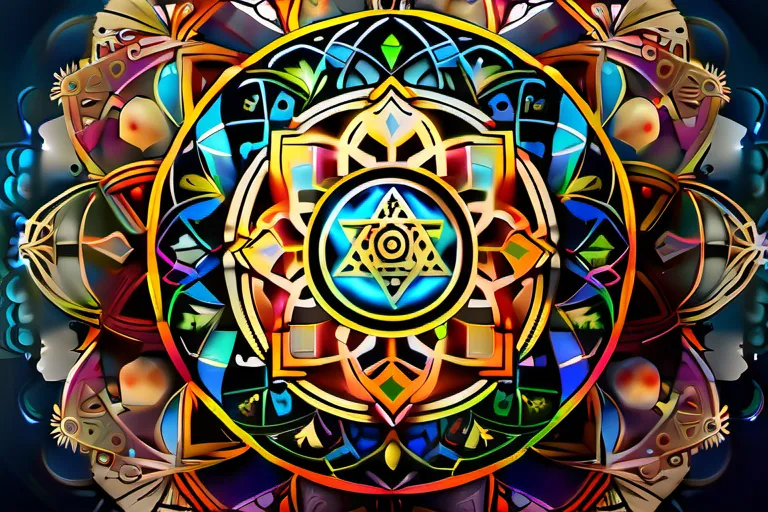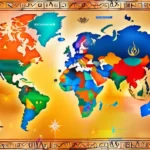Delve into the fundamental teachings and practices of Christianity, Islam, Hinduism, Buddhism, and Judaism.
In this article, we will embark on a journey to explore the core beliefs that define the world’s five major religions: Christianity, Islam, Hinduism, Buddhism, and Judaism. We will delve into their origins, key teachings, practices, and how they have shaped human history.
The Origins and Founders of Christianity
Imagine stepping into the pages of history, where the life of Jesus Christ intertwines with the birth of one of the world’s major religions: Christianity. Born in Bethlehem around 4 BC, to a humble family in the shadow of the Roman Empire, little did anyone know that this young man from Nazareth would soon become the central figure of an entire spiritual movement.
Christianity began with a simple yet profound question: “Who is Jesus?” Some saw him as a prophet; others as a healer. But to his followers, he was more than just a teacher—he was the son of God. His teachings emphasized love, forgiveness, and compassion, which resonated deeply with people facing oppression under Roman rule.
The core belief in the divinity of Jesus Christ is what sets Christianity apart. Christians believe that through his sacrifice on the cross, humanity can find redemption. This crucifixion became a pivotal moment, symbolizing the ultimate act of self-sacrifice and forgiveness.
As Christianity spread throughout the Roman Empire, it faced numerous challenges. The early followers were often persecuted for their beliefs. Yet, despite these obstacles, the religion flourished. It was through the efforts of apostles like Paul that Christianity began to gain traction among both Jews and Gentiles alike. Paul’s missionary journeys and letters played a crucial role in establishing churches across Asia Minor.
From its origins in the first century AD, Christianity has evolved into a global phenomenon with diverse interpretations and denominations. Each one holds onto the fundamental teachings of Jesus Christ, adapting them to fit their cultural contexts while remaining true to the essence of faith.
As we explore the origins and spread of Christianity, it’s hard not to wonder: How did this simple man from Nazareth inspire such a vast and enduring religion? The answer lies in his message of love, hope, and redemption—a message that continues to resonate with people around the world today.
Islam: The Sublime Oneness of God
Islam, often referred to as al-Dīn al-Kāmel, meaning ‘the complete religion,’ centers around the oneness of God, known in Arabic as Tawhid. Could it be that in a world filled with divisions and contradictions, Tawhid offers a beacon of clarity and unity? This concept is not merely intellectual but deeply personal, calling believers to recognize the singular sovereignty and majesty of Allah. How can we truly understand our purpose if we fail to grasp this fundamental truth?
The Five Pillars of Islam form the foundational structure upon which Muslims build their faith. These pillars are like the bedrock of a house, providing stability and support. First is Shahada, the declaration of faith—a simple yet profound statement that encapsulates Tawhid. Could you imagine a life where your beliefs are so clear and concise? Next comes Salat, or prayer, which connects believers with Allah five times daily. How often do we stop to truly communicate with the divine in our fast-paced lives?
The third pillar is Zakat, obligatory charity that ensures wealth is distributed justly. It challenges us to reflect on what we have and how much we are willing to share. Fasting during Ramadan, the fourth pillar, demands self-discipline and reminds us of our human limitations. Finally, there’s the Hajj pilgrimage to Mecca, a once-in-a-lifetime journey that unites Muslims from around the globe in shared devotion.
The life of Prophet Muhammad is integral to Islamic belief. His revelations through the angel Gabriel came at a time when Arabia was steeped in polytheism and tribal conflicts. Imagine living in a society where every aspect of your daily life was intertwined with idol worship; how would such a revelation reshape your worldview? Muhammad’s journey, marked by both trials and triumphs, serves as a model for Muslims to follow, embodying virtues like humility, courage, and compassion.
Through the teachings of Islam, one can find a path that is not only spiritually fulfilling but also deeply human. In a world where we often struggle with our sense of identity and purpose, Tawhid offers a profound answer. It is more than just believing in one God; it is about living as if every moment matters, guided by the light of faith.
Hinduism: The River of Life
Imagine diving into a vast river that flows through time and culture, carrying the wisdom of millennia. That river is Hinduism, often referred to as the ‘Sanatana Dharma’, meaning the eternal way. Within this river, we find a diverse landscape of beliefs, practices, and deities that have shaped societies across India and beyond.
At the heart of Hinduism lies the concept of Dharma. It’s not just about religion; it encompasses one’s duties, rights, laws, conduct, virtues, and ‘right way of living’. Think of Dharma as the lifeblood that keeps society thriving. But how does one find their path? This is where Karma comes in—a term many have heard but few truly grasp. Karma is often misunderstood as a system of punishment and reward; instead, it’s about the consequences of one’s actions. The belief goes that your current situation is the result of your past deeds. So, “Can you navigate life without considering the ripples you create?”
Moksha, the ultimate goal in Hinduism, means liberation from the cycle of birth and rebirth (reincarnation). It’s like reaching the summit after climbing a mountain range, where one achieves inner peace and unity with Brahman, the ultimate reality. Reincarnation is central; it’s seen as a series of lifetimes where one learns and grows to eventually find Moksha. The question is, “How many lifetimes are enough to understand the true essence of existence?”
Hinduism’s pantheon of gods and goddesses adds layers of complexity and richness. From Shiva, the destroyer of illusions, to Vishnu, the preserver of the universe, each deity represents different aspects of reality. But beyond the individual deities, there is a profound belief in the unity of all beings under one supreme reality, reflecting the interconnectedness of life.
Exploring Hinduism is like peeling back layers of an onion; each layer reveals more depth and complexity. Whether through rituals, meditation, or devotion, the path to understanding this ancient faith is multifaceted. It’s a journey where every step brings new insights into the nature of existence itself. As you delve deeper, “What aspects of Hinduism resonate with your own beliefs about life?”
Buddhism: The Middle Way
Buddhism, like a winding path through a dense forest, offers a unique route to enlightenment that differs significantly from the paths trodden by other major world religions. Its journey begins with the life of Siddhartha Gautama, better known as the Buddha, who sought answers to the suffering he witnessed in his kingdom.
Who was Siddhartha Gautama? Born into a royal family around 563 BCE, he lived a sheltered and luxurious life until he ventured beyond the palace walls. Witnessing the suffering of old age, sickness, poverty, and death, Siddhartha began to question the nature of existence and sought answers. After years of extreme asceticism and self-denial, he sat under the Bodhi tree and achieved enlightenment.
The Buddha’s realization was that true peace could not be found through the extremes of luxury or asceticism but rather by finding a middle way. This journey is akin to navigating between two cliffs: one too steep with indulgence, the other perilous with self-denial. The Four Noble Truths outline this path:
- The truth of suffering (Dukkha): Life is inherently difficult and filled with pain.
- The truth of the cause of suffering: Craving and attachment are at the root of our struggles.
- The truth of the cessation of suffering: By eliminating craving, we can end suffering.
- The truth of the path leading to the cessation of suffering (the Eightfold Path): Right understanding, right intention, right speech, right action, right livelihood, right effort, right mindfulness, and right concentration.
Meditation, or jhana, serves as a crucial tool in this journey. It is like tuning the radio to find the perfect station; through meditation, one can quiet the mind and gain deeper insights into the nature of reality. This practice helps practitioners let go of their attachments and eventually realize Nirvana—a state of enlightenment where suffering ceases.
By exploring Buddhism’s core beliefs, we uncover a profound and practical approach to living that emphasizes mindfulness and compassion. It is a journey not just for monks but for anyone seeking to find meaning in life amidst the chaos and confusion of existence.
Judaism: The Covenant with God
Imagine stepping into the ancient world of Judaism, where a covenant with God forms the very essence of its beliefs and practices. How did this religion, with its deep roots in history and tradition, come to be? The story begins thousands of years ago with the patriarch Abraham, chosen by God to establish a unique relationship. This relationship was sealed through a series of promises and commandments, making Judaism not just a set of beliefs but a living contract between humanity and the divine.
The core teachings of Judaism revolve around the Torah, which includes both the Five Books of Moses (the first five books of the Hebrew Bible) and other sacred texts. These texts guide not only what Jews believe but also how they should live their daily lives. The Torah is more than a religious text; it’s a blueprint for ethical living, social justice, and moral behavior. It teaches the Ten Commandments, emphasizing respect for God, honesty, and treating others with kindness.
The Talmud, another vital component of Jewish life, is a vast collection of discussions, teachings, and interpretations that provide detailed guidance on how to apply the Torah in everyday situations. The Talmud offers insights into the nuances of faith and practice, making it a dynamic and ever-evolving part of Jewish tradition.
Through its focus on Mitzvot (commandments), Judaism encourages its followers to engage in acts of kindness and charity, both as personal observances and communal obligations. This emphasis on ethical living makes Judaism a religion deeply concerned with the well-being of individuals and society at large.
As you explore the rich tapestry of Jewish beliefs and practices, one can’t help but wonder: How has this ancient tradition shaped not only the lives of its followers but also the world? The impact of Judaism is profound, influencing other religions, philosophies, and even the development of Western civilization. Understanding its core teachings provides a window into the enduring influence of the covenant with God.
The Impact of World Religions on Human History
The impact of world religions on human history is as profound as the rivers that carve canyons through solid rock over millennia. Have you ever wondered how these ancient belief systems have shaped not only our spiritual lives but also our political and social landscapes? Let’s dive into this fascinating journey.
Christianity, with its roots in the teachings of Jesus Christ, has left an indelible mark on Western civilization. Consider the magnificent cathedrals that dot Europe’s landscapes—each a testament to the faith that inspired such architectural marvels. But Christianity’s influence extends far beyond aesthetics; it played a pivotal role in shaping medieval European society and later influenced the founding principles of democracy, emphasizing freedom and human rights.
Islam, founded by Prophet Muhammad, has similarly reshaped the world through its teachings and practices. The construction of mosques like the Hagia Sophia or the Great Mosque of Samarkand serves as a reminder of how Islamic culture thrives in diverse environments. Politically, the concept of dawah (inviting to Islam) underscores the belief that spreading knowledge is a sacred duty, influencing governance and societal norms.
Hinduism’s profound influence on India’s social structures is undeniable. The caste system, though controversial today, has deeply influenced the socio-political fabric of the subcontinent for centuries. Philosophically, Hindu teachings such as karma and dharma have shaped ethical frameworks that impact daily life and governance in many countries.
Buddhism, originating from the teachings of Siddhartha Gautama, has spread across Asia and beyond, influencing art, literature, and societal values. The practice of meditation and mindfulness has become a global phenomenon, promoting inner peace and spiritual growth. Politically, Buddhist principles have influenced governance in various countries, advocating for non-violence and moral integrity.
Judaism, with its rich history and central texts like the Torah, laid down the foundation for monotheistic religions. The concept of a covenant between God and His people has had far-reaching implications, influencing Jewish identity and law. Politically, the establishment of Israel in 1948 was a direct result of these profound religious beliefs.
Each of these religions—Christianity, Islam, Hinduism, Buddhism, and Judaism—has woven itself into the very fabric of human history, leaving an indelible imprint on art, architecture, politics, and society. Their influence is as vast and varied as the stories they tell, each adding a unique hue to the colorful tapestry of human civilization.
Conclusion
 By understanding the core beliefs of these religions, we gain a deeper appreciation for the diversity and richness of human spirituality. This knowledge can foster greater empathy, tolerance, and mutual respect among people of different faiths.
By understanding the core beliefs of these religions, we gain a deeper appreciation for the diversity and richness of human spirituality. This knowledge can foster greater empathy, tolerance, and mutual respect among people of different faiths.











